#use of drones in agriculture
Explore tagged Tumblr posts
Text
Benefits of Drones in Agriculture | ePropelled Discover how agricultural drones boost crop yields, reduce costs, and improve precision farming. Learn the key benefits for modern farmers and agribusinesses.
#benefits of drones in agriculture#agricultural drones#drone technology in farming#precision agriculture drones#use of drones in agriculture#how drones help farmers#smart farming technologies#drones for crop monitoring#drone applications in agriculture#farming with drones#drones in sustainable agriculture#advantages of drones for farming#unmanned aerial vehicles in agriculture#ePropelled drone motors#electric propulsion for drones#ePropelled#ePropelled systems#ePropelled solutions
0 notes
Text
Samli Drones
Chinese drone restrictions in the US
what will they do to the crop-spraying industry? As costs rise and supply chains collapse, the shift provides room for farming innovation.
The future belongs to local farmers and innovative drone tech!
#agriculture drone#sustainable farming#precision agriculture#drone technology#chinese drones#US drones
1 note
·
View note
Text
US Agricultural Drone Market: Current Analysis and Forecast (2024-2032)
According to a new report by UnivDatos Market Insights, the U.S. Agricultural Drone Market is expected to reach USD million by 2032 by growing at a CAGR of ~23%.
Agricultural drones have in the recent past been the most radical development in the farming industry in the United States in terms of response to challenges of farming as well as resources used in farming. These UAVs are now revolutionizing farming practices, crop management, yield, and of course, cost control. With a continuously increasing number of farmers and producers requiring precision agriculture, the use of agricultural drones in the United States is on the rise and has lately featured prominently in the media for the likelihood of promoting sustainability and efficiency.

Precision Agriculture: The Spine of Drone Systems
New areas that have helped drive the use of agricultural drones are precision agriculture which is the use of innovation in farming. Since drones operate as flying sensors and provide first-hand information on crop conditions it is easier for farmers to determine when to irrigate or fertilize the crops, or possibly use pesticides. In the U.S., huge fields as the fundamentals of the farming industry these drones assist with controlling the huge acres of territories functionally.
Multispectral cameras on drones can shoot images and the colors of the light will tell the health of plants. Knowing stress factors, for example, drought or pest attack on crops, farmers can address those areas more effectively without having to waste water, fertilizers, or pesticides. It not only helps to decrease the operating expenses but also contributes to the development of equitable and ecologically sustainable agriculture undertakings.
Higher Usage as the Demand for Online Marketing Intensifies
The U.S. agricultural drone market is recording impressive growth because of the growing need for sophisticated, efficient solutions for farming. Current information implies that the demand for agricultural drones in the United States is likely to rise at more than a 15% CAGR during the next five years. This is owing to the increase in the demand for high accuracy in planting, lack of adequate labor, and increased concern about the environmentally friendly methods of farming.
Especially, big farming businesses are likely to enjoy the drone advances because it helps them oversee their produce more efficiently, and gather a ton of data. Even mere smallholder farmers have embraced the innovation since cheap models and easy-to-use software are also available in the market. With more farmers succeeding in making the right decisions to purchase drones, the rate at which this hardware will be used will increase, driving the growth of the market even more rapidly.
The authorities’ participation and the legal environment
The U.S. government has shifted the support of drone use in the agricultural sector by offering the necessary regulations that will favor the use of UAVs. Also, the United States Department of Agriculture (USDA) has been at the forefront in advocating for the use of precision agriculture technologies like drones among farmers. The USDA has also supported farmers requesting funds to enhance these technologies and drive the agricultural drone market.
Access sample report (including graphs, charts, and figures): https://univdatos.com/get-a-free-sample-form-php/?product_id=6901
Technological Progress Promoting Efficiency
The advances in technology now make drones even more attractive for farmers in the United States. Modern agricultural drones have everything from GPS and thermal sensors to machine learning that can analyze crop data on the go. These innovations accurately capture the mapping, crop monitoring, and analysis to assist farmers to increase production effectiveness, while reducing wastage.
There has been advancement, especially in the use of artificial intelligence in drone technology. This kind of drone contains artificial intelligence, which can help them to analyze crop conditions, as well as foresee such problems in advance.
Conclusion
Drone farming as a concept has gradually been making headway in the U.S., thanks in part to innovative companies. By making real-time crop observation and resource management possible, drones are the key to elevating the efficiency of farming techniques known as precision agriculture. With an increased number of people embracing the use of drones and with the developments that have made drones have better capabilities in the future, the agricultural drone market stands a good chance of becoming the next big thing in the future of farming in the United States. The continued support of the governments and increasing recognition of the advantages of this technology may help agricultural drones change and improve the agriculture industry, thus allowing American farmers to meet the needs of tomorrow with intensified competition on the international level.
Contact Us:
UnivDatos Market Insights
Contact Number - +1 9782263411
Email - [email protected]
Website - www.univdatos.com
Linkedin- https://www.linkedin.com/company/univ-datos-market-insight/mycompany/
Related Agriculture Market Research Industy Report:-
MENA Plant-Based Food Market: Current Analysis and Forecast (2023-2030)
Plant-Based Food Market: Current Analysis and Forecast (2022-2028)
0 notes
Text
Best Used Agricultural Drones - Dronesdeli
The best used agricultural drones include models like the DJI Agras MG-1, senseFly eBee, and Parrot Disco. These drones offer reliable performance for crop monitoring and precision spraying at lower prices. Investing in used models allows farmers to enhance productivity and efficiency without the cost of new equipment, making them valuable assets.

0 notes
Text
Newly launched EFT E610M agricultural drone frame
EFT E610M is a multi-purpose drone with an ultra-light drone frame that can be used for pesticide spraying, seed and fertilizer spreading, or modified for industrial applications to meet multiple application scenarios.



#eftdrone#efte610m#ultralight#drone#UAV#farmingtools#dronesprayers#agriculture drone#drone tech#agriculture machinery#Farming use#drone agriculture sprayer#농사용드론#drone agricultura#eft drone official store
0 notes
Text
United States Agriculture Drone market was valued at US$ 72.10 million in 2018 and is anticipated to reach US$ 144.8 million by 2025 displaying explosive CAGR of 9.96% over the forecast period (2019-2025).
0 notes
Text
The Best News of Last Month - August 2024
1.Negative Power Prices Hit Europe as Renewable Energy Floods the Grid

European power markets are experiencing a notable shift as renewable energy sources, particularly wind and solar, become a larger part of the energy mix. On Wednesday, power prices in several European markets, including Germany, dipped below zero due to a surge in green electricity production.
2. Taiwan introduces ban on performances by captive wild animals

Live performances by wild animals held in captivity, including performances by dolphins, tigers, and other non-domesticated mammals, will no longer be permitted in Taiwan under new Ministry of Agriculture (MOA) regulations.
3. FTC bans fake online reviews, inflated social media influence; rule takes effect in October

The FTC voted unanimously to ban marketers from using fake reviews, such as those generated with AI technology, and other misleading advertising practices.
The ban also forbids marketers from exaggerating their own influence by, for example, paying for bots to inflate their follower count.
4. Chinese drones will fly trash out of Everest slopes

Come autumn, Nepal will deploy heavy lifter drones to transport garbage from the 6,812-metre tall Ama Dablam, south of Everest. This will be the first commercial work an unmanned aerial vehicle does in Nepal’s high-altitude zone.
The heavy lifter from China’s biggest drone maker, Da Jiang Innovations (DJI), will take on tasks traditionally handled by Sherpas. Officials believe it will help reduce casualties on Everest.
5. Swiss scientists have found a way to use the whole cocoa fruit to make chocolate and not just taking beans and discarding the rest.

Kim Mishra (L) and Anian Schreiber (R) cooperated on the new chocolate making process
Food scientists in Switzerland have come up with a way to make chocolate using the entire cocoa fruit rather than just the beans - and without using sugar.
The chocolate, developed at Zurich’s prestigious Federal Institute of Technology by scientist Kim Mishra and his team includes the cocoa fruit pulp, the juice, and the husk, or endocarp.
6. Six-year-old boy found in Vietnam forest after five days

A six-year-old boy who was missing for five days has been found deep in a forest in Vietnam. Dang Tien Lam, who lives in the northwestern Yen Bai province, was playing in a stream with his nine siblings on 17 August when he wandered into the hills and got lost, local reports said.
He was found on Wednesday by local farmers who heard a child's cry while they were clearing a cinnamon field close to the forest.
7. Lego plans to make half the plastic in bricks from renewable materials by 2026

Lego plans to make half the plastic in its bricks from renewable or recycled material rather than fossil fuels by 2026, in its latest effort to ensure its toys are more environmentally friendly.
The Danish company last year ditched efforts to make bricks entirely from recycled bottles because of cost and production issues. At the moment, 22% of the material in its colourful bricks is not made from fossil fuels.
----------
That's it for this month :)
This newsletter will always be free. If you liked this post you can support me with a small kofi donation here:
Buy me a coffee ❤️
Also don’t forget to share this post with your friends.
1K notes
·
View notes
Text
Really, watching The Wandering Earth makes Interstellar seem pretty ridiculous in comparison.
In no particular order:
In Interstellar, we are only ever shown the US perspective, and the only time another nation is even mentioned is when the protagonists down a long-abandoned, autonomous Indian Air Force¹ drone - even at the end, when humanity leaves Earth, the space habitats are purely USAmerican, complete with small-town baseball field. In The Wandering Earth, however, a multitude of nations are represented - China is most prominent, but Indian, Kazakh, Russian, Indonesian, Korean, etc. crews are also shown, and are instrumental to the climax of the movie, where only the cooperation of all nations pushing together solves the issue.
While both movies feature the plotpoint of a cynical backup plan to re-seed humanity from frozen embryonic cells, in Interstellar, the best-case plan is evacuating a necessarily small number of people off of Earth, abandoning the planet to its fate. Solving the problem on Earth is impossible. Here, the solution is Noah's Ark. In The Wandering Earth, the best-case plan is to save the Earth, preserving as much of humanity as possible. Most resources are spent on constructing safe cities for humanity that can weather the storm, and on the infrastructure necessary for the Moving Mountains² project. Here, the solution is Great Yu Controls the Waters.
In Interstellar, the result of the crisis in society is a massive reduction in organisation. Governments basically cease to exist, armies are dissolved, and humanity turns to rural, agricultural production. Despite this, they are able to construct and launch complex interplanetary space missions, with secrecy even. In The Wandering Earth, the result of the crisis in society is a massive increase in organisation. A world government is formed to unite as many forces as possible, and a massive project of industrialisation occurs, in order to carry out the work needed to save the Earth. The construction of the Earth Engines is shown to have taken decades, with long periods of difficult experimentation.
In Interstellar, the focus is on the immediate family, on the protagonist's children. It is a tragedy that the protagonist spends thirty years in space, but the mission to leave Earth happens quickly enough that he can still see his daughter again, on the spaceship full of cornfields and single-family houses. In The Wandering Earth, the focus is on all generations to follow. The project being undertaken will not bear fruit for centuries, and in those centuries the people working for it will face extreme difficulties and struggle. But, many, many years from now, it will provide a good life for the children of a future Earth.
¹Originally, this was to be a Russian drone, operated by the Chinese military. The movie's plot originally included a conflict against secretive Chinese space forces who attack the protagonists.
²The Foolish Old Man Moves the Mountains is a Chinese fable, about an elderly man who begins carving out a path in the mountainside - when asked why, even though he'd never quarry through the mountain in his lifetime, he answers that others will follow his work, and one day the pass will be complete. It was referenced by Mao Zedong as a metaphor for the long construction of socialism in China, estimated at the time to take a hundred years or more to achieve a developed and prosperous society.
246 notes
·
View notes
Text
"When Francois Beyers first pitched the concept of 3D ocean farming to the Welsh regulators, he had to sketch it on napkins.
Today the seafood farm is much more than a drawing, but if you walked along the Welsh coastal path near St David’s, all you’d see is a line of buoys. As Beyers puts it: “It’s what’s below that’s important.”
Thick tussles of lustrous seaweed suspend from the buoys, mussels cling to its furry connective ropes and dangling Chinese lantern-esque nets are filled with oysters and scallops.
“It’s like an underwater garden,” says Beyers, co-founder of the community-owned regenerative ocean farm, Câr-y-Môr. The 3-hectare site is part of a fledgling sector, one of 12 farms in the UK, which key players believe could boost ocean biodiversity, produce sustainable agricultural fertiliser and provide year-round employment in areas that have traditionally been dependent on tourism.
Created in 2020 by Beyers and six family members, including his father-in-law – an ex-shellfish farmer – the motivation is apparent in the name, which is Welsh for “for the love of the sea”. ...
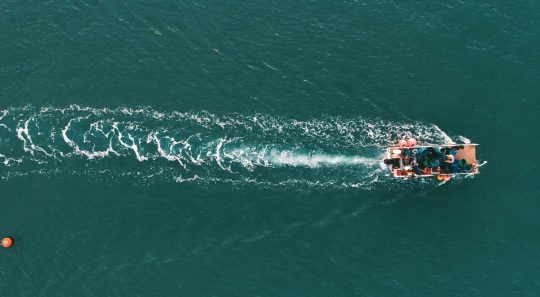
Pictured: Drone shot of Câr-y-Môr, which is on the site of abandoned mussel farms. Image: Scott Chalmers
Ocean farming comes from the technical term ‘integrated multi-trophic aquaculture’, which means a mixture of different seaweed and shellfish species growing together to mutually benefit each other. But it’s not just a way of growing food with little human input, it also creates ocean habitat.
“You’re creating a breeding ground for marine animals,” explains Beyers who adds that the site has seen more gannets diving, porpoises and seals – to name a few – since before the farm was established.
Ocean farms like Câr-y-Môr, notes Ross Brown – environmental research fellow at the University of Exeter – have substantial conservation benefits.
“Setting up a seaweed farm creates an exclusion zone so fishermen can’t trawl it,” explains Brown, who has been conducting experiments on the impacts of seaweed and shellfish farms across the UK.
Brown believes a thriving ocean farming industry could provide solutions to the UK’s fish stock, which is in “a deeply troubling state” according to a report that found half of the key populations to be overfished. “It would create stepping stones where we have safe havens for fish and other organisms,” he adds.
But UK regulators have adopted a cautious approach, note Brown and Beyers, making it difficult for businesses like Câr-y-Môr to obtain licenses. “It’s been a tough old slog,” says Beyers, whose aim is to change the legislation to make it easier for others to start ocean farms.
Despite navigating uncharted territories, the business now has 14 full-time employees, and 300 community members, of which nearly 100 have invested in the community-benefit society. For member and funding manager Tracey Gilbert-Falconer, the model brings expertise but most importantly, buy-in from the tight-knit local community.
“You need to work with the community than forcing yourself in,” she observes.
And Câr-y-Môr is poised to double its workforce in 2024 thanks to a Defra grant of £1.1 million to promote and develop the Welsh seafood industry as part of the UK Seafood Fund Infrastructure Scheme. This will go towards building a processing hub, set to be operational in April, to produce agricultural fertiliser from seaweed.
Full of mineral nutrients and phosphorous from the ocean, seaweed use in farming is nothing new, as Gilbert-Falconer notes: “Farmers in Pembrokeshire talk about their grandad going down to the sea and throwing [seaweed] on their farms.”
But as the war in Ukraine has caused the price of chemical fertiliser to soar, and the sector tries to reduce its environmental impact – of which synthetic fertiliser contributes 5% of total UK emissions – farmers and government are increasingly looking to seaweed.
The new hub will have capacity to make 65,000 litres of sustainable fertiliser annually with the potential to cover 13,000 acres of farmland.
But to feed the processing hub, generate profit and reduce their dependency on grants, the co-op needs to increase the ocean farm size from three to 13 hectares. If they obtain licences, Beyers says they should break even in 18 months.
For now, Beyers reflects on a “humbling” three years but revels in the potential uses of seaweed, from construction material to clothing.
“I haven’t seen the limit yet,” he smiles."
-via Positive.News, February 19, 2024
#wales#welsh#ocean#marine biology#aquaculture#marine life#marine animals#seaweed#sea scallops#oysters#united kingdom#uk#conservation#conservation news#overfishing#environmental news#farming#sustainable agriculture#sustainability#ocean farming#good news#hope
491 notes
·
View notes
Text
The near future in the Doctor Who universe sure gets dire doesn't it? Especially if Mad Jack / Roger ap Gwilliam is still part of history.
I thought I'd have a bit of fun listing things out, combining as many sources as possible. Turns out he fits in shockingly well with what we know. There's a lot missing here or cut out, and for obvious reasons it's very UK / Europe focused, but nonetheless:
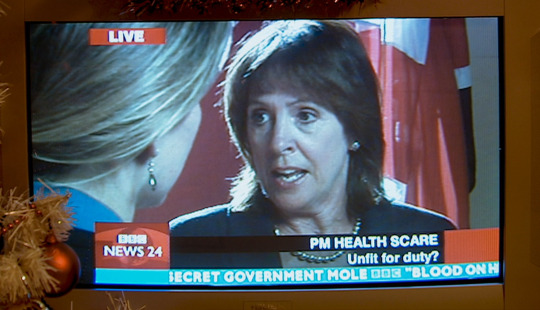
[ID: Scene from The Christmas Invasion showing Harriet Jones on BBC News. The news ticker reads "PM HEALTH SCARE", "Unfit for duty?", and references a "SECRET GOVERNMENT MOLE" and a quote: "BLOOD ON [HER HANDS]".]
2006-2021 (obviously the past now, but still noting for the resulting temporal and political butterfly effect) - In the original timeline, Harriet Jones remains Prime Minister for 3 consecutive terms, presumably 15 years assuming no snap election was called, referred to as a 'golden age' [World War Three]. The Tenth Doctor deliberately changes history to cause her deposal [The Christmas Invasion], leading to numerous disastrous terms in the meantime, including those of Harold Saxon [The Sound of Drums et al.], Brian Green (who tried to appease the 456) [Children of Earth], Boris Johnson (an auton host of the Nestene Consciousness) [Rose (novelisation)], and Jo Patterson (responsible for deploying cloned Dalek defence drones in the UK's streets) [Revolution of the Daleks].
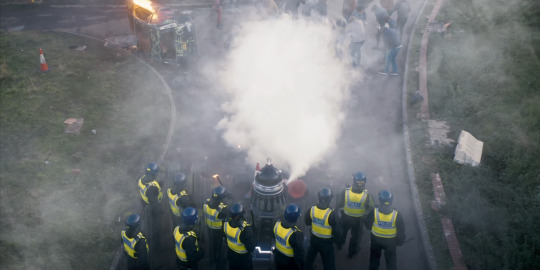
[ID: Scene from Revolution of the Daleks. A 'defence drone' Dalek is used to support anti-riot police in a test, dispersing protestors with mock tear gas.]
2010s-2030s - The European Union gradually integrates further, eventually becoming the European Zone / Eurozone, a global superpower which competes with the USA through the 21st century. The UK eventually forms part of the bloc [Trading Futures].
It's likely that Harriet Jones's deposal led to this and related events being delayed or erased, with Brexit (driven by, among others, one of Jones's successors in the new timeline) reducing european unity. Most notably, Ramón Salamander's rise to power occurs now not in the 2010s [The Enemy of the World], but in the 2030s [Doctor Who and the Enemy of the World]. There are other events that are seemingly delayed by ~20 years by changes to the timeline, including future events like the dictatorship of Mariah Learman [The Time of the Daleks, Trading Futures], and yet also possibly past events like the death of Queen Elizabeth II [Battlefield, The Longest Night et al.], which may suggest something else (eg. the Time War) may be responsible.
~2030 - During a time of rising global tensions [73 Yards], Ramón Salamander convinces a group of scientists in an underground shelter endurance experiment that nuclear war has broken out on the surface. They are convinced to generate artificial "natural" disasters to fight back against the enemy. Between this and ongoing climate change, several global food sources collapse as a result, including Canada and Ukraine's corn and flour production [The Enemy of the World].
2031 - Tensions culminate in the "Great Russian War". Despite posturing, not a single nuclear weapon is fired, at least by NATO [73 Yards]. This may be later considered World War III [Trading Futures].
~2032-2035 - Following the war, tensions rise again, now between the Eurozone and the USA [Trading Futures], possibly in reaction to actions (or lack thereof?) taken by NATO during the war [73 Yards]. Both send separate peacekeeping forces to conflict in North Africa. Meanwhile, Italy is engaged in civil war [Trading Futures].

[ID: Scene from The Enemy of the World, showing Ramón Salamander.]
Over the decade, Ramón Salamander rises in power in the World Zone Authority, using his patented "Sun Store" satellite technology to aid the growth of crops by controlling sunlight over agricultural regions. In the background, he murders and blackmails officials to place loyalists into powerful positions, with the goal of ruling over the World Zone Authority as a dictator. Salamander's treachery is later discovered and he disappears [The Enemy of the World].
2037 - 2042 - Several militia declare wars of Independence from the USA. Notably, Phoenix, Arizona is destroyed in a terrorist attack. While the country largely persists after the conflicts, some territories seem to successfully secede - with, for example, a Montana Republic seemingly being in existence in 2054 [Alien Bodies].
2038 - The World Zones Accord is signed. This is later considered to have reduced the United Nations to a 'joke' compared with the World Zone Authority [Alien Bodies]. Given the extensive power it gives to the WZA, this was likely originally part of Salamander's plan, but due to his disappearance he is not around to reap the rewards [The Enemy of the World].
2039 - A group of Mexican astronauts studying minerals on the Moon go missing [Kill the Moon].
~2030s - 2040s - The Earth begins to experience major climate change effects, including "appalling storm conditions" which harm agriculture [The Waters of Mars]. The ice caps melt and flood much of the Earth [K9] with nations like the Netherlands ending up entirely flooded [St Anthony's Fire]. Some regions experience corrosive acid rain [Cat's Cradle: War Head, Strange Loops]. One summer sees Britain experience a 22 week drought. At this time, the Eurozone closes its borders to millions of North African and Baltic Sea refugees [Hothouse]. This time period may be known as the "Oil Apocalypse" [The Waters of Mars].

[ID: Scene from K9 Episode 13: Aeolian. Big Ben stands in the middle of a colossal storm of wind and rain.]
With Earth's ecosystems collapsing [Davros], humanity begin to realise it's facing extinction [The Waters of Mars]. An artificial cooling agent is spread in the atmosphere to semi-successfully combat the effects, but leads to dramatic side-effects, including freezing some areas of the globe. This is known as the "Great Cataclysm" [K9].
2041 - A three-human team, including Adelaide Brooke, lands on Mars for the first time [The Waters of Mars]. However, with this accomplishment, and increasing turbulence on Earth, Humanity gradually loses interest in space exploration [Kill the Moon].
Before 2045 - Around this time, the UK falls into a dictatorship ruled by the "Director", head of a military council that has allegedly (secretly?) controlled the government since 2028 [Britain Protests]. It is possible that this Director was previously the "Minister of War" for previous governments [Before the Flood].
2045 - The World Zones Authority evolves into a World Government, with Nikita Bandranaik being elected President. The UK is not part of the organisation [This is 2065].
2046-2050s - The Director is overthrown [Down with the Director] and the rest of the government "collapses in shame" [73 Yards]. Some of the revolutionaries celebrate now being "masters of [their] own country" [Down with the Director]. Despite the hopes of the World Government for international integration, this nationalistic streak continues.

[ID: Scene from 73 Yards. Roger ap Gwilliam, with an Albion Party ribbon on his chest declares victory on BBC News, live from Kennington High in London. Headline reads "LANDSLIDE VICTORY FOR ALBION PARTY: Majority of 92 predicted. Roger ap Gwilliam declared Prime Minister."]
Roger ap Gwilliam is elected Prime Minister, with the far-right nationalistic Albion Party gaining a majority of 92 MPs [73 Yards]. While his government does take the step to officially join the World Government senate [Down with the Director], he seeks greater independence from other nations. One of his first actions is to expand the UK's nuclear arsenal, purchasing missiles from Pakistan and withdrawing from NATO. In his term, the world is brought to the brink of nuclear war [73 Yards], likely in the pre-2050s "Euro Wars" [The Time of the Daleks].
In this time, the "Department", a (private?) multinational security organisation is born, based primarily in the UK. They gain broad powers, which they use to control populations with propaganda and use of "CCPC"s: robotic law enforcement notorious for their surveillance and brutality. Despite its recent revolution, the country is rendered practically a police state [K9].

[ID: Scene from K9 Episode 1: Regeneration. CCPCs, hulking police robots, march down a dark alley.]
2049 - The Moon starts to dramatically gain mass, causing massive tides on the Earth, flooding entire cities. In a last ditch at survival, humanity plans to try and destroy the Moon using an array of nuclear bombs. Despite the people of Earth being offered the vote on what to do by turning off their lights, it appears the decision is made on a national level, with lights going off grid-by-grid. Nonetheless, the Moon is allowed to hatch, leaving behind a new less massive egg "moon" with minimal further destruction [Kill the Moon].

[ID: Scene from Kill the Moon. The Moon hatches in the background, as the TARDIS stands by the sea.]
Humanity's interest in space exploration returns [Kill the Moon], starting a new space race. Among these projects, Australia begins constucting a space elevator, Spain a project called "SpaceLink", while Germany and Russia each begin a series of new Moon missions. The Philippines are rumoured to be planning their own landing on Mars [The Waters of Mars].
~2050 - The UK Government (ap Gwilliam's?) is couped once more, by General Mariah Learman. With the King's permission, elections are suspended for at least a couple years, with her ruling over a "benevolent dictatorship". She is later abducted and forcibly mutated by the Daleks [The Time of the Daleks]. Despite the previous description, her promotion of Shakespeare in schools is remembered as the only good thing about her rule [Trading Futures]. (Note: As mentioned prior, it's likely that Learman's rule may have been delayed as Salamander's was. This is suggested by the mention of her in Trading Futures, set seemingly ~2030s or earlier, despite The Time of the Daleks taking place around the 2050s.)
~2050s - The Gravitron is built on the new Moon. This is used to artificially control the tides and weather [The Moonbase]. It likely also is intended to study and monitor the new Moon for future changes [Kill the Moon].
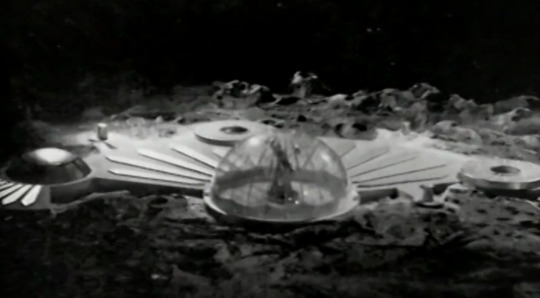
[ID: Scene from The Moonbase, giving an external shot of the base.]
2058 - 2059 - Bowie Base One is established: humanity's first colony on another planet and an international collaboration between the UK, USA, Russia, Germany, Turkey, South Korea, Lithuania, Australia, and Pakistan. One year later, it is mysteriously destroyed in a deliberately triggered nuclear explosion. In the original timeline, there were no survivors. However, after the interference of the Time Lord Victorious, the true story is eventually told on Earth. Regardless "a veil of darkness" sweeps over the planet over the next few years. [The Waters of Mars], as international tensions heat up once more... [Total Eclipse of the Heart].
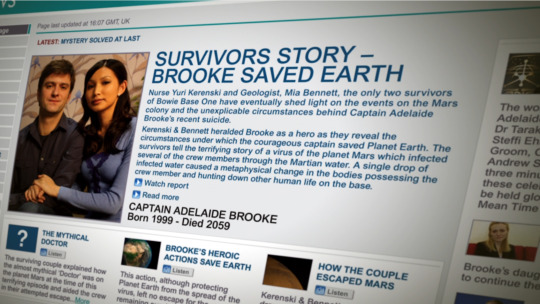
[ID: Scene from The Waters of Mars, showing an internet news website. Various articles appear focused on the Bowie Base One incident, including "SURVIVORS STORY - BROOKE SAVED EARTH", "THE MYTHICAL DOCTOR", "BROOKE'S HEROIC ACTIONS SAVE EARTH", and "HOW THE COUPLE ESCAPED MARS". The feature image shows the two survivors: Yuri Kerenski and Mia Bennett.]
2060s - The "Great War" breaks out on Earth, involving every country on Earth. This is likely World War IV. Details are vague, but it ultimately ends in a ceasefire, when it's realised the conflict is risking Earth's habitability [Total Eclipse of the Heart].
381 notes
·
View notes
Text
Working swiftly, the men unlocked a storage unit crammed with drones and canisters of pressurized gas. Using a dolly, they wheeled out four tanks containing sulfur dioxide and helium, and stacked them on the floor of the camper van. Then, almost as quickly as they arrived, they were on the road, headed for the golden hills near the Pacific Ocean. With their jury-rigged equipment and the confidence that comes with having raised more than $1 million in venture capital, they were executing a plan to release pollutants into the sky, all in the name of combating global warming. [...] Make Sunsets is one of the most unusual start-ups in a region brimming with wild ideas. Iseman, 41, and his co-founder, Andrew Song, 38, claim that by releasing sulfur dioxide into the stratosphere, they can reflect some of the sun’s energy back into space, thereby cooling the planet. [...] So far, the company is releasing sulfur dioxide on a tiny scale. But some experts say that broader efforts to disrupt the delicate interactions between the Earth’s atmosphere, ocean, land and sea ice could result in catastrophic unintended consequences. For example, blocking sunlight could interfere with the monsoon season, which is critical for agriculture, income and food supply in India. Animated by the “move fast and break things” credo that permeates Silicon Valley, the founders of Make Sunsets have no such concerns. They are selling “cooling credits” to customers who want to offset their personal carbon emissions. And a few times each month, after selling enough credits, they head for the hills and release balloons full of sulfur dioxide into the California sky.
I feel like this violates the non-aggression principle
74 notes
·
View notes
Text
US Agricultural Drone Market Trends, Challenges, and Future Prospects
US agriculture drones market is anticipated to reach the market valuation of US$ 144.8 million by 2025 expanding at a reasonable CAGR of 9.96% in the course of the forecasted period (2019-2025) from US$ 72.1 million in 2018. Drones are being used for wide variety of purposes in the last couple of years. They began as toys, and then found their application for military purposes. To add on, Amazon and Walmart began testing their own versions of drones for package delivery services, even Google has jumped in the respective segment. Some drone companies have also tested the significance of drones for medical and emergency delivery services. Moreover, approval by FAA to fly a drone in United States has further resulted in the adoption of the devices in agriculture sector. Hence, agriculture drone has begun to be used for agricultural purposes. Digital Agriculture is mainly the use of advanced technologies that are integrated into one system and enables the farmers and other stakeholders within the value chain to enhance the crop yields and improving food production. It has been observed that by 2021, digital agriculture market will be evaluated at US$ 15 billion and around 80% companies are expecting competitive advantage from Agriculture Revolution 4.0. In addition to this, with more than 65% of the food supply required to feed surging population by 2020, digital agriculture portrays immense potential to transform the way the food is produced.

With the accelerated benefits of agriculture drones in precision agriculture, rising demand for food owing to the surging population, agriculture getting stronger with Big Data along with increasing research & development investments has tremendously accelerated that demand for agriculture drones in United States. However, lack of internet connectivity in rural areas, high initial cost of purchase and other parameters such as weather conditions, flat and small view of objects, flight time and flight range, object overlap have remained a huge challenge for the agriculture drone market in United States. With the rapid technological breakthrough, farmers are opting for agricultural drones to enhance their agricultural productivity. Being one of the newest and efficient tools in agriculture, they assist the farmers in wide range of tasks from analyzing, planning to the actual planting of crops, and the subsequent monitoring of fields to ascertain health and growth of crops. Furthermore, surging investments by established players along with favorable government policies are expected to allow large and small operations to aid in effective farming practices. For instance, in 2016, US investments in agricultural drones and robotic technology amounted to US$ 389 million and approximately 40 companies raised funds. Investors such as Monsanto, Syngenta and Mitsui have backed various emerging start-ups for improving, harvesting, crop spraying and irrigation. The rising trend of implementation of UAVs for enhanced productivity and increasing awareness of precision agriculture for crop scouting and field mapping is expected to drive the adoption of drone in agriculture sector in the US.
Under the different types of the agriculture drone market, fixed-wing drones occupied maximum share in 2018. Fixed-wing agriculture drones are considered to be the best choice to monitor the field. They are primarily used when to lot of ground needs to be covered at a fast pace. It has been observed fixed-wing agriculture drones can cover up to 10 times the acreage that a typical quadcopter can cover in a single flight. The segment is anticipated to bring in earnings of US$ 56.03 million by 2025. Under various applications of agriculture drones in US market, crop spraying application is projected to enjoy the swiftest expansion in the United States throughout the reviewed period of time accredited to its superior benefits in terms of massive reduction in overall spray and much lower chemical level reaching the groundwater. With the usage of agriculture drones, the farmers can complete spraying jobs about 5 times faster than traditional methods. Moreover, the application is projected to register stable CAGR of 10.40% over the forecast period.
Request for Sample of the report browse through https://univdatos.com/report/us-agricultural-drone-market-current-scenario-and-forecast-2019-2025
Additionally, for better investigation and penetration of drones in the United States agriculture sector, a detailed regional level analysis was conducted including North East, Midwest, South and West regions. In 2018, Mid-West was one of the lucrative and the largest region in terms of adoption of agriculture drones in the US. On account of strong government support to increase the agriculture production, availability of supporting infrastructure as well as gaining prominence of smart and precision farming methods have significantly fostered the regional market. Moreover, more than 25,000 farmers using IoT in US paired with increased deployment of advanced agriculture solutions both in United States along with small farms steadily increasing investment in precision and smart farming methods to raise farm productivity have tremendously boosted United States Agriculture Drone Market. Some of the major companies profiled in United States agriculture drone market are Aero Vironment Inc, Trimble Inc, AgEagle Aerial Systems, Inc., Precision Hawk, Sentera Inc, Drone Deploy, Deveron, DJI, Intel and John Deere Company. The players consistently aim to focus on various product launches, innovations, energy-efficient products as well as mergers and acquisitions to enhance the penetration rate of agriculture drones across United States thereby strengthening their market position.
Contact Us:
UnivDatos Market Insights
Email - [email protected]
Contact Number - +1 9782263411
Website -www.univdatos.com
0 notes
Text
SKELETONS | ch. 71
daryl dixon x f!oc
masterlist
a03 link

Summary: Rick, Iris and Daryl go out scavenging. Their search is fruitful, but not in the way they intended. Warnings/Information: AMC's The Walking Dead OC Insert | 18+ Advised | strangers to lovers; the slowest of slow burns; gore; angst; horror; humour; m/f; teasing; flirting; robbery
Chapter 71 - Strangers
“You sure you want to come?” Daryl asked as they stepped out of the infirmary, walking down the steps together. They had a run planned, just Daryl, Iris and Rick. To grab a few things to hold them over while Tara and Heath headed out for a couple weeks to gather more.
“Of course.” Iris beamed. “God knows you and Rick are helpless without me.”
“Mm.” He grunted, his voice low. “Maybe one of us.” Iris’ lips curled into a bashful smile and Daryl smirked, sliding his hand smoothly into her back pocket. They meandered onto the road, where Denise was walking toward them.
“Hey.” She called. Iris waved, Daryl pulling out the list she gave them with his spare hand. “Everything make sense?”
“Yeah, we should be good.” Iris nodded, looking over the list as Daryl held it out to her. “This, at the bottom… you want—“
“Yeah.” Denise cut her off, nodding. Iris raised an eyebrow, but nodded.
“It’s not medical.” Daryl grunted.
“No, I drew a line between the important stuff and that.” She replied. “I just figured… if you saw it.” Daryl shrugged, nodding. “Anything remotely medical is a priority, and food, maybe even food before medicine, and gas or batteries or books for the kids or clothes is just—“
“We got it, Denise.” Iris said, smiling softly. “We’ll grab it if we see it.”
“Why you want it?” Daryl asked, adjusting the bag on his shoulder. Denise took a step closer, smiling sheepishly.
“Tara was talking about it in her sleep, I think. Either she likes it or she doesn’t, but if she likes it, it would be a really nice surprise.” She explained. “I’m not good with that kind of stuff, and she and Heath are going on that two-week run. I just thought it’d be a nice going away present. Just, uh, don’t go out of your way.” Daryl turned away, trying and failing to hide his growing smile at the notion. Iris pinched him, smiling back at Denise.
“Okay.” She nodded. She let out a small yelp as Daryl pinched her, using the hand that was not occupied by the list. Denise smiled at them, nodding as she turned and hurried back into the infirmary. Iris turned to Daryl, slapping his hand away. “Really?”
“What?” He grunted, beginning to saunter off toward the gate, where they would eventually meet with Rick to head out on their run. Iris trailed after him, shaking her head.
They got into the car she’d prepped for them, gassed up and ready for them to be out for a while. Iris was also happy to sit in the back and relax while Rick and Daryl bickered in the front like an old married couple. Eugene let them out at the gate, leaning into the window to hand Daryl a folded piece of paper.
“I mapped out some of the agricultural supply places in the area. Even if they’ve been cleaned out, my bet is that the sorghum would be untouched. Now that there is a criminally underrated grain that could change the game with our food situation from scary to hunky-dunky. I’m talking standability, drought tolerance, grain-to-stover ratio that is the envy of all corns. Think about it.” He droned.
“Thanks.” Daryl said lowly, looking up at Eugene while they waited for him to stop leaning on the car. He nodded and they drove off, letting him close the gate behind them.
“What is that guy on?” Iris groaned, leaning her head back against the seat. Rick chuckled, shaking his head.
“I’ll give him one thing, he knows a lot of shit.” He offered.
“Yeah, and no sack to be seen.” Daryl grunted. They laughed, Rick continuing on to the road they’d mapped out before.
“Today’s the day.” Rick declared.
“Uh-huh.”
“Gonna find some food, some people. The law of averages has gotta catch up.” Rick argued.
“I don’t know, we ain’t seen nobody for weeks.” Daryl pointed out. “Maybe we ain't gonna find nobody. Maybe that’s a good thing.” Rick sent Daryl a look, glancing back at Iris as he grabbed a nondescript CD from the console. Iris groaned, and Daryl sighed. “Don’t. Please don’t. Don’t.”
Rick began snapping along to the dulcet tones of Ronnie Dawson’s “Action Packed,” Daryl shooting him a withering look. Rick only turned it up, Daryl pinching the bridge of his nose as he turned to face the window.
“Draws ‘em away from home!” Rick yelled over the voice.
“And kills us slowly.” Iris muttered, laying down across the backseat and pressing her bag to her uncovered ear.
-
The song was nearly over after Rick played it for the sixth time when they breezed by a crossroads, Iris sitting up straight when Daryl called for Rick to stop. The car lurched into reverse, enough for Rick and Iris to turn and eye up the building Daryl had spotted. A fenced off field, a few silos and the word “sorghum” painted across the rooftop of a building in big, red, block letters. Rick turned the car down that road and they parked right outside the shed, hopping out. Iris was thankful to whichever merciful god allowed for the music to stop.
Rick and Iris rounded the small building, scoping out the entrances and exits while Daryl rifled through his backpack.
“Hey, hold up. Best to be safe.” Daryl called, walking up to the large rolling garage door. “Cover it?”
“Yeah.” Iris and Rick said simultaneously, glancing at one another as they pointed their weapons toward the door. In one large, smooth motion, Daryl lifted the door open, revealing an empty garage and a large semi-truck.
“We're good.” Rick called. He gestured to the back door of the truck with his gun. “One more time?”
“It’s not locked.” Iris pointed out. Daryl ripped the door open, revealing entire pallets and crates and boxes of food, drinks, canned goods and other products. It went all the way to the back, and Iris gasped loudly. “Holy shit.”
“Well, how about that?” Rick said with a large grin. Daryl leapt up into the truck, inspecting the wrapped and packaged boxes of food. “The law of averages.”
“Yep.” Daryl grunted.
“Let’s get this thing going. Grab our gear, come back for the car later.” Rick suggested. “We can take another way back, see what we can see.”
“Think it’ll start?” Daryl asked, grabbing the strap and pulling the door closed.
“Yeah, I do.” Rick said confidently, grinning. Iris rolled her eyes.
“I’ll make it start.” She ensured.
They got into the truck, Iris squeezing between Daryl and Rick on the one bench seat, beginning to drive their way back. After only a few minutes, they came upon a run-down gas station that appeared to have been ransacked. It looked like it might have been abandoned before the turn, but with their streak of luck, Rick wasn’t about to pass it by.
They pulled in, quickly doing a sweep. Daryl pulled on the doors without opening them, waiting to see if any walkers slammed up against the glass from inside. Nothing. He turned around, eyeing a large vending machine that was laid on its side against the ground.
“Yo, give me a hand with this.” He waved, Rick coming over. Iris watched amusedly as the two men heaved at the machine, attempting to turn it over, to no avail. “Want to give us a hand, princess?”
“Oh no, you guys are doing great.” Iris replied, grinning as she threw them a thumbs up. Rick sighed exasperatedly.
“I don’t think we got it.” He admitted. Daryl grunted, grabbing his crowbar and looking around.
“I got an idea.” He said, moving back to the truck.
“That’s why I smelled something burning.” Iris muttered, Rick shaking his head with a snicker as they watched him back the truck over to the machine.
Rick grabbed a chain, tying it around the machine before attaching the ends to the truck hitch. He whistled, Daryl driving forward until the machine flipped over. Iris whistled and Daryl stopped the truck, coming over to examine the vending machine.
“It’s soda and candy… why the trouble?” Rick asked.
“It’s on the list.” Iris replied, flicking the piece of paper with a finger. Rick raised an eyebrow.
“Wasn’t any trouble.” Daryl said with a shrug.
Rick was suddenly slammed forward into the vending machine, grunting in pain as a single man stumbled to the side, the three of them whipping out their guns to point at him. He wore a long leather duster and a knit hat, black leather gloves. A white piece of fabric was tied over his face like a mask, long hair brushing where his collar bones would be.
“Hi.” He panted, his hands up in defence.
“Back up! Now!” Daryl barked.
“Keep ‘em up!” Rick added.
“Whoa, easy, guys. I was just running from the dead.” He said calmly, keeping his hands out in front of him. Iris walked backward and turned to look down the small alleyway he’d emerged from.
“How many?” Daryl asked.
“Ten, maybe more.” The man replied. “I’m not risking it. Once it gets to double digits, I start running.”
“Where?”
“About a half a mile back.” He answered. “They’re headed this way. You probably have about… eleven minutes?” Rick turned to Iris and she shook her head. None in sight.
“Okay. Thanks for letting us know.” Rick said lowly, holstering his gun. He kept his angry face on though, and Iris raised an eyebrow as she sheathed her knives. The man nodded, shrugging.
“Yeah. There’s more of them than us, right? Gotta stick together.” He stated. He looked to Daryl, raising an eyebrow. “Right?” Daryl huffed, lowering his gun begrudgingly. “You have a camp?”
“No.” Daryl answered.
“Do you?” Rick asked. Iris kept careful watch of him, and he stared at her right back.
“No.” He replied. He shrugged, sighing. “Well, sorry for running into you. I’m gonna go now. If this is the next world, I hope it’s good to you guys.”
“I’m Rick!” Rick called after he turned around. The man turned back, glancing over his shoulder. “This is Daryl, and Iris. What’s your name?” The stranger turned around fully, pulling down his mask to reveal a thick beard. The look suited him.
“Paul Rovia.” He replied, spreading his arms wide. “But my friends used to call me Jesus. Take your pick.”
“You said you didn’t have a camp.” Rick stated. “You on your own?”
“Yeah.” Jesus answered. He had a mischievous twinkle in his eyes. “But still, best not to try anything.”
“Best not to make threats you can’t keep, either.” Daryl warned. Iris shifted her weight, putting a hand on her hip as she raised an eyebrow.
“Exactly.” Jesus agreed. He turned around, beginning to jog away.
“How many walkers—“ Rick started.
“No, not this guy.” Daryl huffed, turning to interrupt. Rick ignored him.
“How many walkers have you killed?” Rick called.
“Sorry!” Jesus called, his back still turned. “Gotta run. You should, too. Think you've got about seven minutes.” Daryl grumbled.
“What the hell was that?” He grunted.
“I liked him.” Iris grinned, turning to them. Daryl made a face.
“Really?” He asked. Iris shrugged.
“He’s…” She trailed off, unable to find the right word. Endearingly obnoxious? She might use the same words to describe herself. Daryl scoffed, folding his arms.
“He was clean.” Rick pointed out. “His beard was trimmed. There’s more going on there.”
“He didn’t have a gun either.” Daryl replied.
“That we saw.” Iris shrugged.
“We could track him,” Rick suggested, “watch him for a while, get to know more. See if he’s really alone. Maybe bring him back.”
“And risk the supplies?” Iris replied. “I don’t think we should.”
“Nah.” Daryl grumbled. “Guy calls himself Jesus.”
The three of them whipped around, guns out as gunshots echoed in the distance. They were a little muted, but close enough to warrant caution. They crept along the side of the building searching for the source, single file, Rick, Daryl, Iris. Their steps sounded different. Why would they sound different? Iris looked down, noting the lack of keys hanging from Rick’s belt. They stopped at the corner, Rick scowling. Iris turned around, bolting for the truck.
“Firecrackers.” He grunted. They went off again inside a large oil drum, set by someone on purpose. “Shit.”
“Ah, hell.” Daryl said simultaneously. The two of them turned to see Iris gone, realizing a second too late as they ran after her.
“Son of a bitch.” Iris grumbled, skidding to a stop as Jesus slammed the driver’s side door closed behind him. He leaned out the window, grinning.
“Sorry, gorgeous.” He said insincerely, saluting with one hand. She sprinted after him as the truck sped away, just one jump away from the back step.
“Iris!” Daryl yelled. She skidded to a stop, Daryl and Rick panting as they came up beside her, all three of their chests heaving. He even took the damn vending machine, it swaying roughly behind the truck.
“Shit.” Rick repeated. Iris sucked on a tooth, sighing loudly.
“Alright boys.” She said, tightening the straps of her knife harnesses and the belt of her gun. “Time for some cardio.”
Rick and Daryl looked at one another as Iris started running, the two of them a few paces behind as they went after the truck.
-
TAGLIST:
@heidiland05
@ryoujoking
@catlalice
@maxinehufflepuffprincess
@lowkeyhottho
@fadingpalacebonkpsychic
@hayley1998
@negansbestie
@lizey-thornberry
#thenameisz#daryl dixon#skeletons#the walking dead#the walking dead daryl dixon#twd daryl#twd daryl dixon#daryl dixon x oc#daryl dixon x original character
22 notes
·
View notes
Text
Homo Mousike updated species refs + redesigns!


The Debu didn't get a redesign, more like an updated reference picture but nonetheless, the current Debu lore:
Debu are the most technologically behind out of all 3 sophonts in the homo mousike planet, they are in their stone age and still live in caves. They have recently begun to be sedentary to practice agriculture, and while they don't have metals, they have invented cement, where they will dig/carve out molds to pour it in and create whatever structure they need. They are an immensely successful species that have been sapient for significantly longer than the two Zebrapeople, yet have not moved meaningfully past their stone age, but this technological lag isn't due to a intellectual damper, but a lack of need.
Debu are enourmous, strong, but because their skin is bare and sensitive, if they they can't beat the daylights out of their attackers, they can just scale cliffsides as dubiously as a mountain goat and create massive caves for themselves for shelter. They are HEINOUSLY well adapted and the only reason they got sapient was because tool use got Debu insane amounts of hoes.
Debu used to be solitary, and they would call to one another like birds and at some point down the line, 1 proto-Debu was getting insane play because he was knocking on shit rhythmically while singing. This led to 2 species-wide realizations: Girls like cool sounds, so if you can make cooler sounds (by making instruments) you get more girls, and If MULTIPLE guys play together in a little band, they collectively get way more girls. These 2 combined brought the species to be communal through "concerts" and sapience through the tool use.
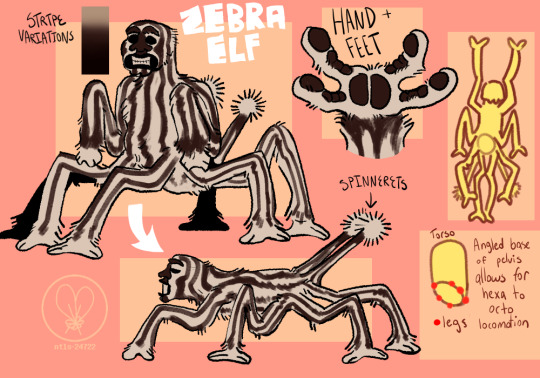
Zebrapeople are the most technologically advanced, in terms of humans, they're kind of at their ancient Sumerian point in history - meaning technically their world history just started but that's still miles ahead of the Debu.
Zebraelves came from something that kind of filled the niche of monkeys, crawling along land-coral branches like chameleons but became semi-hexapodal when their ancestor adopted their eusocial nature, in order to carry food across the branches to the rest of their colony. Speaking of, they have a eusocial social structure where most of the population are nonreproductive worker females, nomadic drones that group into a fraternity and migrate circularly around subcolonies to lay pipe to the reproductive female Queens that are thrice their size (around the size of humans)
Their biggest strength, as you might expect, lies in their eusocial nature - much like Argentine ants, the entire species is a part of one massive supercolony, meaning the entire species, fascinatingly, does not have wars with one another. Subcolonies do have tensions and general beef, of course, they're not a hivemind, but they're just extremely passive aggressive about things. Their tool use was actually what facilitated this - the Zebraelves were smart before this, and were not just workers in a colony, having much time to play. Any neighboring colonies would fight tooth and nail against eachother, the only truces being over liquor and their dances, where two colonies would temporarily relieve tensions to play and mess around. The intraspecies violence was actually insane to the point that inventing instruments to make larger dances and merge colonies actually became essential to their survival.
Wars with other species is on the table, as hypocritical as that is. Interestingly, they like to siege war on their "cousins" the most.

The Zebramen evolved from Zebraelves on an island close to the mainland, their eusociality and treedwelling status fading away as they got bigger and bigger. Eventually, like us, they became fully hexapodal to run across flat ground rather than across land coral branches. Interestingly, their civilization didn't start when they stopped being nomads, their civilization started when they got up and began to keep moving across the savannah. Inventing instruments for music helped them communicate as they herded the cattle that their entire livelihoods relied on, without wasting so much precious breath.
Interestingly, even though they're their closest extant relative, zebraelves are kind of hardwired to hate zebramen the most - to most zebraelves, zebramen are recognized as a seperate supercolony and there is some instinctual tension. But peace and union between the two species is not rare nor unheard of, cultural exchange is abundant and the two species are so closely related that hybridization occurs, creating the variably fertile, back problem-prone and human-sized zebragnomes.
Zebramen have 2 main ethnicities at this time, the black-and-white mainland zebramen, and the hot-pink insular zebramen, located exactly as their names suggest. They are big fans of the razzle dazzle, as when they were without queens and fraternity nomads, their evolution began to skew towards sexual selection, leading to an enjoyment of overly detailed, fancy decor and the bright-pink stripes on the insular Zebramen to this day.
#FALLS APART#I HAD THIS IN MY DRAFTS FOR 2 DAYS#OUGH#SO MUCH LORE#ntls-24722#djmm#dj music man#fnaf djmm#djmm fnaf#fnaf dj music man#dj music man fnaf#music man#music man fnaf#fnaf music man#ffps music man#windup music man#mini music man#homo mousike#speculative biology#worldbuilding#(almost) daily music man#fnaf au#security breach au#ffps au#digital
56 notes
·
View notes
Text
EXCLUSIVE: Republican Sen. Pete Ricketts is leading the charge with Democrat Sen. John Fetterman to codify oversight on foreign countries buying American farmland.
The bipartisan Agricultural Foreign Investment Disclosure (AFIDA) Improvements Act seeks to implement recommendations published by the Government Accountability Office (GAO) in January 2024, which found the AFIDA was ill-equipped to combat foreign ownership of American agricultural land.
"Communist China is our greatest geopolitical threat," Ricketts told Fox News Digital in an exclusive interview, adding, "This is a way for us to improve the disclosure that's going on with regard to the purchase of this agricultural land, so we can take other action if necessary to make sure we're not giving Communist China the opportunity to buy agricultural land."
The bill's proposal comes as two Chinese nationals – a University of Michigan post-doctoral research fellow, Yunqing Jian, and Huazhong University of Science and Technology student Chengxuan Han – were held in federal custody after they were accused of smuggling biological materials into the United States.
RICKETTS, FETTERMAN TEAM UP FOR CRACKDOWN ON CHINA'S ATTEMPTS TO PURCHASE US FARMLAND
The suspects have been charged with "smuggling a fungus that has been described as a "potential agroterrorism weapon" into the heartland of America, where they apparently intended to use a University of Michigan laboratory to further their scheme," interm U.S. Attorney for the Eastern District of Michigan Jerome Gorgon said in a statement.
The fungus causes a "head blight," described as a disease of wheat, maize, rice and barley, and is responsible for billions of dollars of economic losses throughout the world each year, according to the Department of Justice. If ingested by humans, the substance can cause vomiting, liver damage and "reproductive defects in humans and livestock."
Department of Homeland Security Assistant Secretary Tricia McLaughlin told Fox News Digital that the Trump administration is focused on "keeping our homeland secure" through enhanced border screenings.
"Protecting America’s food supply and national security remains a top priority. Last week’s smuggling attempt by Chinese nationals of Fusarium graminearum, a dangerous crop-destroying fungus, posing a significant bioterrorism threat, only highlights this imperative to combat this threat," McLaughlin said.
"That could potentially be very damaging to agriculture," Ricketts told Fox News Digital. "We also know that Chinese nationals have been trying to steal our biotechnology with regard to agriculture. They've also been crashing gates of bases. Supposed Chinese tourists have been flying drones around bases. Of course, the Chinese flew a surveillance balloon over our country when the Biden administration just let that happen."
Ricketts said China has been aggressively buying American agriculture, "which is why we need to have a heightened sense of vigilance around protecting our homeland."
Foreign investors own over 40 million acres of agricultural land in the United States, and between 2010 and 2021, Chinese ownership of American agricultural land increased from 13,720 acres to 383,935 acres, according to the U.S. Department of Agriculture (USDA).
"It's not just about the number of acres that they own, but the fact that they own it around Grand Forks Air Force Base in North Dakota or Fort Liberty in North Carolina. They're buying it around sensitive military installations," Ricketts said.
The bill, also co-sponsored by Sens. Tommy Tuberville of Alabama, John Cornyn of Texas, Roger Wicker of Mississippi and Rep. Don Bacon of Nebraska, requires AFIDA reporting for foreign persons holding more than 1% interest in American agricultural land.
The AFIDA Improvements Act aims to increase information-sharing between the Committee on Foreign Investment in the United States and the USDA. It also requires updates to the AFIDA's handbook and establishes a deadline for USDA to set up an online AFIDA system.
Based on the GAO's recommendations, the bill seeks to update the Agricultural Foreign Investment Disclosure Act of 1978 to better equip the USDA to combat foreign adversaries’ ownership of American agricultural land.
"We are at the most dangerous point in our history right now since World War II," Ricketts said. "We have to be investing in our military. We have to be supporting our friends around the world that are pushing back on these dictators. Communist China is one of them."
Additionally, the bill comes as conflict in the Middle East reaches a boiling point between Iran and Israel, reigniting concerns about national security. Israel successfully coordinated attacks against Iran from inside the country, and Ricketts pointed to Ukraine's success in targeting a Russian air base.
"What Ukraine was able to do against Russia with their operation that destroyed some of their strategic bombers, and they placed trucks with drones close to an air base and had those drones attack their squadrons. We could be vulnerable to the same thing if China did that here. They've owned farmland close enough to our air bases to be able to launch a drone strike. That should be very concerning to us," Ricketts said.
Ricketts added that American farmland should not be a "tool that our adversaries, like Communist China, can use to attack us from inside our own country."
There has been little movement on the bill since it was just recently introduced. That is largely because Senate Republicans are narrowly focused on advancing Trump's "big, beautiful bill" ahead of a self-imposed July 4 deadline.
7 notes
·
View notes
Text

🟦 Sunday - events from Israel
ISRAEL REALTIME - Connecting to Israel in Realtime
( VIDEO - Fadi rocket damage in the Krayot, north of Haifa. Large rocket, large damage. )
♦️IDF: During the night and morning hours, about 150 rockets, cruise missiles and UAVs were launched towards Israel.
♦️COUNTER-TERROR OPS - SHECHEM.. forces in action in Shechem today, during a routine counter-terrorism operation in the Kasbah of Shechem, IDF fighters opened fire on terrorists who threw stones and Molotov cocktails. A number of terrorists were wounded by security forces.
♦️An Israeli military official: "The operations in Lebanon prevented a more difficult morning, we will intensify the attacks.” The IDF is preparing to intensify the attacks in Lebanon not as part of a response, but part of the war plans.
♦️GAZA.. fighting continues all over Rafah, in recent days there are still pockets of resistance even in places that the army cleared months ago.
▪️ENGLISH HOSPITAL NAZARETH.. four victims of rockets from Hezbollah, two from shrapnel and two from anxiety, were treated and released.
💩HEZBOLLAH SAYS.. A senior member of Hezbollah: The meeting in which Akil and the top officials of Hezbollah (and the Radwan invasion force) were killed in Da'ahia, Beirut was intended to examine a plan for a ground invasion of Israeli territory in response to the beeper bombs.
💩THE ROCKETS.. Hezbollah is firing Fadi 1 and 2 rockets, 220 mm and a range of up to 85 km, and 302 mm with a range of up to 105 km, respectively. Best guess on comparative rockets puts the warheads at around 100 kg and 150 kg. In comparison the Katyusha, which they have been firing large quantities of at the near-border towns, is about 10 kg warhead, and the Grad, also being fired in quantity, is 21 kg. So these rockets have medium range and moderately heavy damage.
They are not a precision weapon.
▪️ ISRAEL ON THE UK.. President Herzog on Sky News: "There is a sense of disappointment in Israel with the conduct of the new government in Britain towards it."
▪️US SENDING.. Against the backdrop of the escalation in the north: the US is sending another aircraft carrier to the Middle East after having sent one of the two in the area back home.
▪️US VICTIMS SAY.. Relatives of Americans who were murdered in Akil's attacks against the US embassy and marine barracks in the 1980’s in Beirut: "Israel has a long memory, justice has been done.”
⭕20 rounds of ROCKET and SUICIDE DRONE fire from Hezbollah so far since 6:00 this morning. And a particular round may now include 10-30 targets.
🇮🇱HOME FRONT COMMAND - alert level 3 - HAIFA, TIBERIUS, and north, including the Golan, Safed, etc. - School: closed, Workplaces: only where it is possible to reach a protected space in 1 minute, Restriction of gatherings - in a building up to 10 people, in an open area up to 100 people, the IDF also cancels agricultural work in the areas near the border in the north.
🔸ANXIETY / MENTAL HEALTH HOTLINES: experiencing issues? Hotlines & help is available..
.. in English : Tikva Helpline by KeepOlim, call if you are struggling! dial 074-775-1433.
.. in Hebrew & other languages (and English): Eran Emotional Support Line - dial 1201 or chat via eran.org.il
#Israel#October 7#HamasMassacre#Israel/HamasWar#IDF#Gaza#Palestinians#Realtime Israel#Hezbollah#Lebanon
20 notes
·
View notes